HTC Desire X Review
HTC Desire X
A mid-range Android phone for those who can't quite afford an HTC One X.
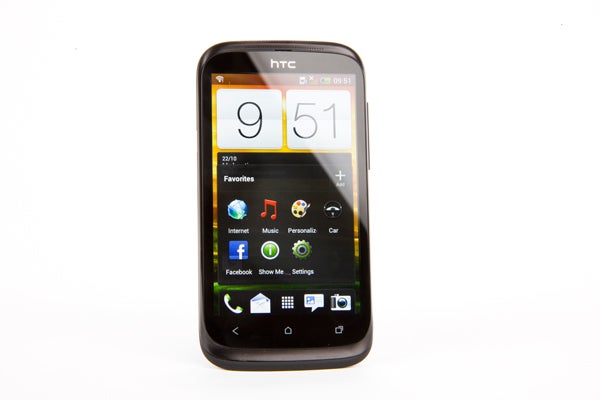
Verdict
Pros
- Neat, slim design
- Decent screen
Cons
- No front-facing camera
- Mediocre main camera
- No HD video capture
Key Specifications
- Review Price: £234.99
- Dual-core 1GHz Qualcomm MSM8225 Snapdragon CPU
- 768MB RAM
- 5-megapixel camera with LED flash
- 4-inch 480 x 800 pixel Super LCD screen
- 4GB internal memory
The HTC Desire X is a phone that shows you don’t have to spend all that much money to get an Android phone that feels fairly high-end. At under £250 SIM-free, it’s priced to compete with mid-range Androids like the Samsung Galaxy Ace 2. It may not cause jaws to drop, but the HTC Desire X is a phone that even the smartphone elite should be able to live with easily enough.
Watch our HTC Desire X video review:
HTC Desire X Design
The HTC Desire X resurrects one of HTC’s classic smartphone ranges. The original HTC Desire, released in 2010, was one of the first phones that the occasional gran knew, alongside the hordes of phone geeks. It was a class act.
Desire is no longer a high-end brand, though. The One range has bumped it down a peg, leaving the HTC Desire X, HTC Desire C and HTC Desire V to supply mid-range phones for those on a slightly restricted budget.
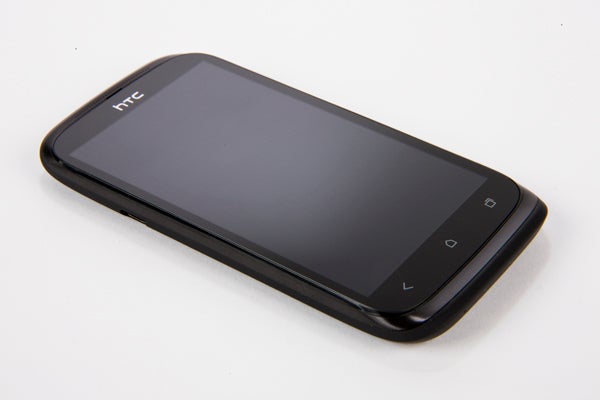
Turn on the critical eye and this is apparent in the HTC Desire X’s bodywork. Where the mid-range HTC One V has a largely metal body, this phone is mostly plastic. There’s a thin strip of metal surrounding the screen, but the rear is covered almost completely by a removable soft touch plastic battery cover.
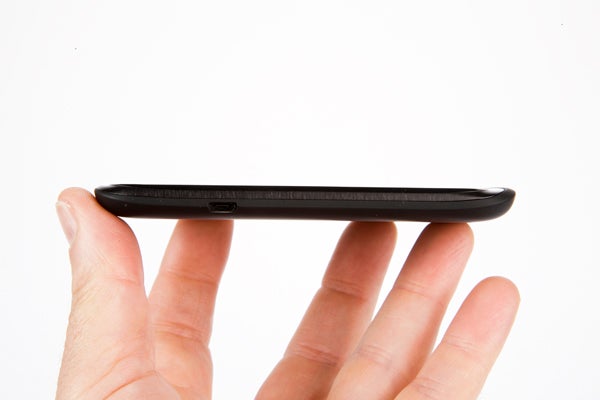
A few design touches stop the HTC Desire X from looking too cheap, though. There’s the unusually large camera sensor surround on the rear, finished in an eye-catching texture of concentric circles. Matched with the small Beats logo on the phone’s rear, it provides the phone with a slightly youth-centric vibe, but not to an extent that should put off grown-up buyers.
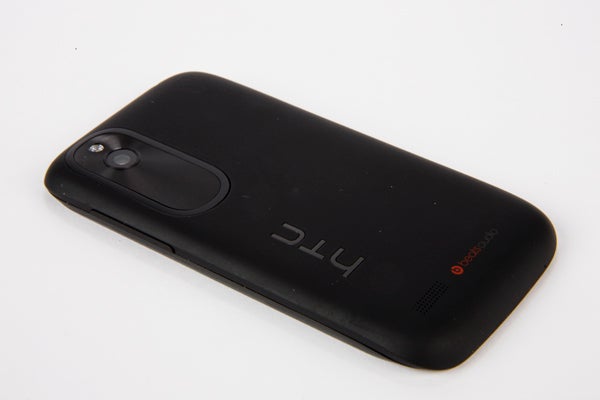
HTC has also produced a bunch of tailored cases if you want to take the look closer towards the unusual. There are hard shell plastic cases with circular cut-outs that let the phone’s bodywork show through.
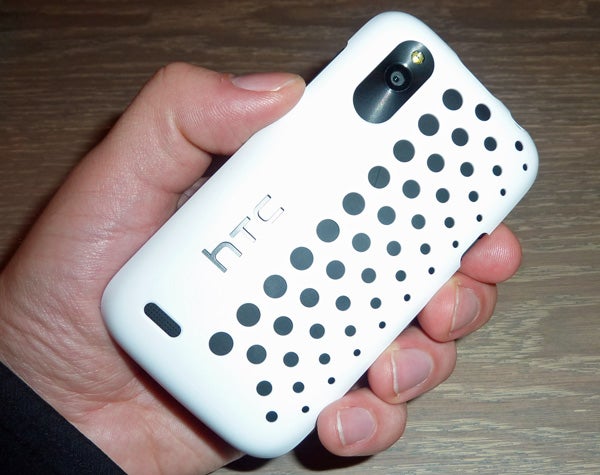
There’s a hint of styling, but the HTC Desire X does feel a little less distinctive than the HTC One V.
Physical connectivity is standard for a mid-range phone like this. There’s a microUSB port on its left edge that also doubles as an MHL video output. Using the right accessory – available for a shade under £20 – the HTC Desire X can output movies to a TV. The positioning of this connector may seem a little odd when the standard is to jam it on the bottom, but it’s consistent with the HTC One X design, letting you use the Desire X with that phone’s dock
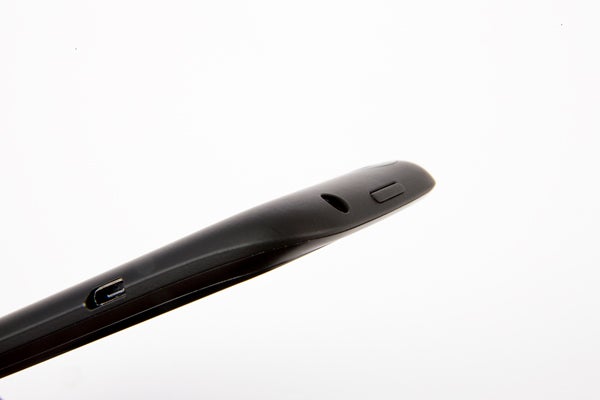
The 3.5mm headphone jack sits up top, just where you’d expect it to be. Although this is the top-end model in the new Desire line-up, its internal storage is minimal at 4GB. However, HTC does include a microSD memory card slot, which lives under the battery cover.
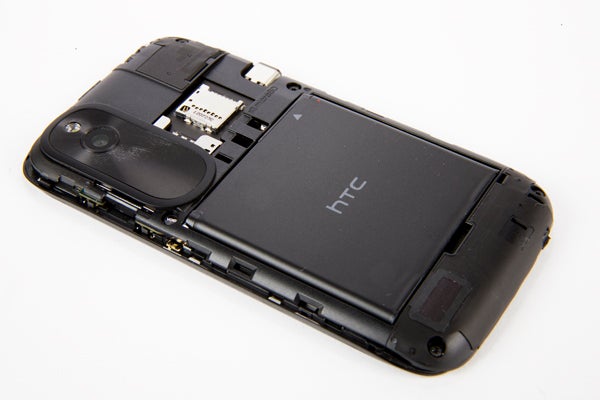
HTC has gone through the standard mid-range moves with the HTC Desire X. It’s smaller than the top-end models, it’s fairly thin at 9.3mm and the largely plastic-bodied design keeps it light at 114g. Aside from the slight lip that’s a genetic throwback to the unibody days of the Desire range, this phone’s good looks feel quite commonplace. But in a reasonably affordable phone this is no bad thing.
Much like its bodywork, the HTC Desire X features a mid-level screen. It’s four inches across and uses a Super LCD screen. Although not quite as high-performing as a true IPS display, it feels a perfect match for a phone of this calibre.
HTC Desire X Screen
With a relatively traditional LCD panel, it avoids the pentile sub-pixel array of most AMOLED phones. Without descending into further technobabble, a pentile array makes text looks less sharp than the resolution of the screen might suggest – and the HTC Desire X couldn’t afford that as its resolution is a relatively lowly 480 x 800 pixels. 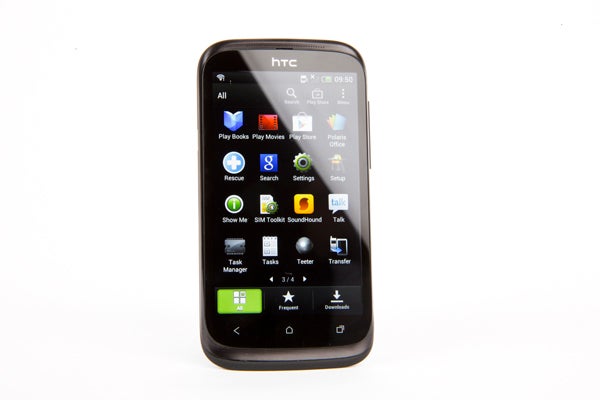
At normal viewing distances, text still looks sharp, but zoom out in the browser and characters quickly become an indecipherable mess of pixels.
The HTC Desire X isn’t entirely free of contrast shift, either. At particular extreme angles, the shadowy veil of this screen issue rolls in, showing that this isn’t quite as high-end a screen as something like the Retina offering found on the iPhone 5. However, in normal use it excels.
Viewing angles, contrast and backlight bleed have all been hugely improved since previous-generation Super LCD screens such as that of last year’s HTC Sensation. Even in darkened rooms, black areas stay black, rather than blue or grey they appear on lesser LCD screens.
The technical limitations are here, but for the most part you have to look for them.
HTC Desire X Interface and Usability
Continuining the theme that the HTC Desire X doesn’t quite have all the latest, greatest toys in its arsenal, the phone runs Google’s Android 4.0 Ice Cream Sandwich OS with a slightly cut-down version of the HTC Sense 4.2 interface. Google has just unveiled Android 4.2 Jelly Bean, and most importantly the phone misses out on the speed increases brought by Android 4.1 Jelly Bean.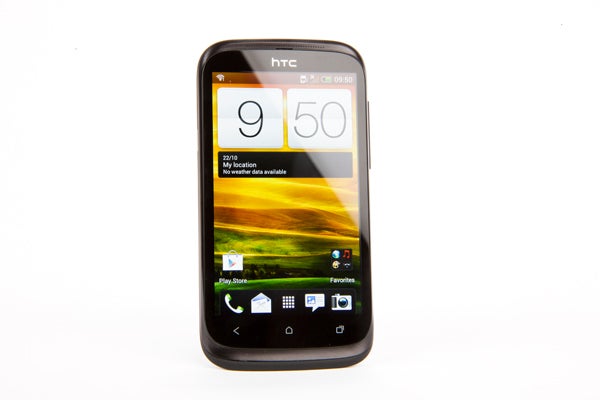
Flicking through the menus of Android isn’t quite as slick as it is in bang up-to-date phones, but performance is actually very good. The HTC Desire X has a 1GHz dual-core Qualcomm MSM8225 Snapdragon CPU with an Adreno 203 processor and 768GB of RAM.
Lag is generally minor aside from the slightly longer pause as apps are opened, and benchmarks results are on-par with the specs, at 5189 in the Antutu bench and 7777 in the sunspider javascript benchmark. Most notably, this trounces the performance of the single-core HTC One V, which is otherwise an attractive alternative to this phone.
HTC Sense fiddles with the look of Android a little, with a custom homescreen icon dock, a tweaked apps menu and a handful of widgets that have helped to cement the iconic HTC Sense look. However, next to the default Android Jelly Bean UI, it is starting to look a little past it.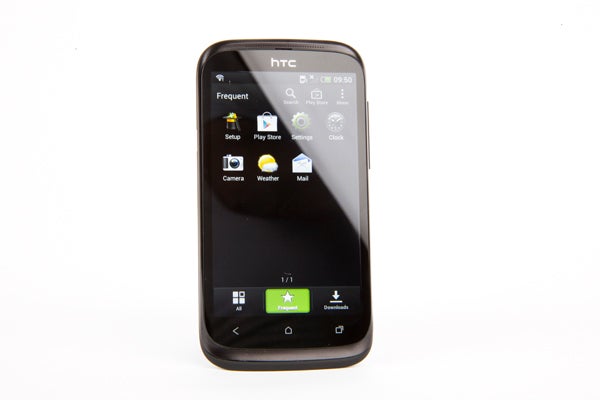
The particular version of HTC Sense in the HTC Desire X tends to look a little boxy and convoluted, occasionally making the UI seem cluttered in its attempts to put features at your fingertips. It also lacks the quick-access settings in the pull-down notifications menu.
Things that you miss from the “full” version of HTC Sense that features in top-end phones like the HTC One X include the 3D multi-tasking nav bar. These are minor issues, though. HTC Sense remains one of our favourite custom UIs, and offers neat features like the active lock screen. This lets you launch into one of four hand-picked apps directly, and does so while looking good too.
You’re given five homescreens to play with as standard, and there’s a custom widget browser that lets you easily pick the home screen to drop widgets into. Widgets pre-installed include calendars, clocks and web bookmarks.
HTC Desire X Contacts, Calling and Browser
HTC Sense offers a particularly good Contacts book, which ties-in notifications from SMSs, emails, social networks and even Whatsapp. Although the Contacts book doesn’t seem a particularly popular way to get your latest social updates, it is a handy way to get an instant update on a friend. But Trusted Reviews does not condone stalking.
Call quality is good, with decent volume and clarity. However, it does not appear to use the active noise cancelling favoured by many other phones.
The HTC Desire X comes with both a generic Android internet browser and the Chorme for Android browser pre-installed. With a fairly fast processor, responsive touchscreen and fairly large screen, this is a great phone for a morning browse.
The virtual keyboard isn’t the most accurate or flexible, and lacks Swype-style input, but it can easily be replaced with another from the Google Play app store. The one significant drawback is that the HTC Desire X’s screen isn’t all that pixel-packed, meaning you’ll often be better off sticking with mobile-optimised websites than the full desktop versions.
There’s just the one camera on the HTC Desire X, a 5-megapixel sensor on the rear with an LED flash on-hand for late-night shoots. If you want to video chat with friends from across the globe, this is absolutely not the phone for you.
HTC Desire X Camera
The main HTC Desire X camera doesn’t impress particularly, either. It’ll do the trick for Facebook snaps and pics of your friends to reminisce over within the phone’s gallery every now and then. However, the level of detail captured isn’t too impressive, shots are quite noisy and even in reasonable lighting there’s a lot of chromatic aberration on show.
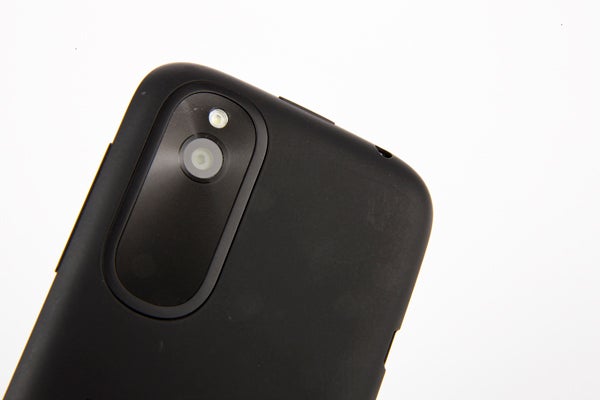
The HTC Desire X camera is not to be taken too seriously, but it does excel at fun. HTC Sense provides its own camera app that’s replete with distorting and arty effects. There’s vignetting, the Instagram favourite shallow depth of field filter, a dotty mosaic and a fistful of the more commonplace colour filter and tone options.
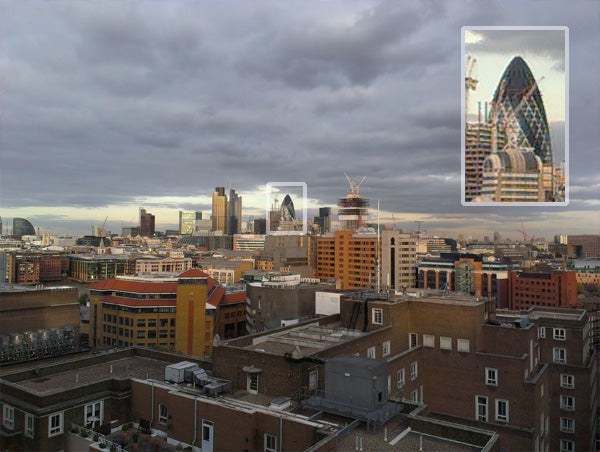

This camera is out for a good time, but video once again shows up its technical limitations. The highest-resolution video the HTC Desire X can capture is 480p. In a dual-core phone with a 5-megapixel sensor, this is bafflingly poor – we’d expect at least 720p in a mid-range phone like this.
HTC Desire X Music
One of the HTC Desire X’s feature calling cards is Beats audio. HTC signed a $300 million deal with the popular headphone maker that saw several HTC headphones bundled with Beats headphones last year.
This year, the partnership has been toned-down a bit. You no longer get an expensive pair of Beats headphones bundled for free, but rather have to make do with a Beats audio mode and a standard pair of HTC buds.
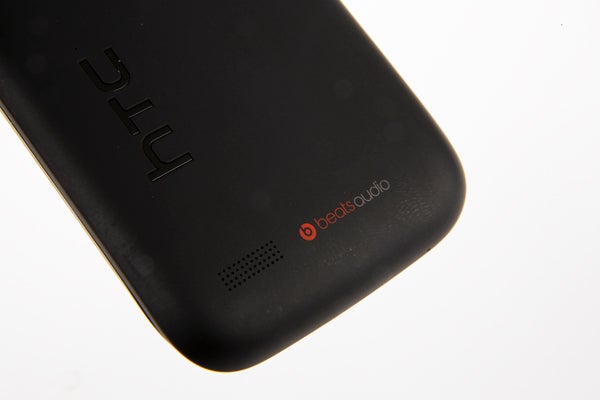
The Beats sound enhancer is a DSP (digital signal processing) mode that aims to make music sound more alive and exciting. It does make the non-enhanced mode sound dull and a little thin, but the Beats mode does appear to over-emphasise the bass a little. No surprise there, given how the Beats Solo HD headphones sound. A little more control would have been appreciated.
The Music app of the HTC Desire X is otherwise good. It corrals in SoundHound, TuneIn Radio and 7Digital streaming alongside access to your locally-stored tunes. It’s a pity the FM radio doesn’t get a nod too, as there is one, accessible from the main menu.
Basic music navigation is good thanks to the fairly fast processor and responsive capacitive touchscreen. However, the app is a little bit too obsessed with displaying album art. An option to view albums or artists as a simple image-free list would have sped-up matters further.
For all its Beats branding may suggest a music obsession, there is a slight noise bed to the HTC Desire X’s output that’s audible when music is played at very low volumes. It’s so slight that it’s not worth worrying about unless you’re mistaking this for an audio-centric device. It’s not one. Top volume is commendably high for a mobile phone, and output is otherwise clear.
Audio fans will be pleased to hear that the HTC Desire X supports FLAC natively too.
HTC Desire X Video Playback
If native audio support is slightly better than average, video playback certainly isn’t. The HTC Desire X refused to play almost all of our test video files, ruling-out playback DivX, MKV and Xvid without a third-party app. This is disappointing when the lowest-end HTC One phone, the HTC One V, included advanced video support – even though it’s less powerful.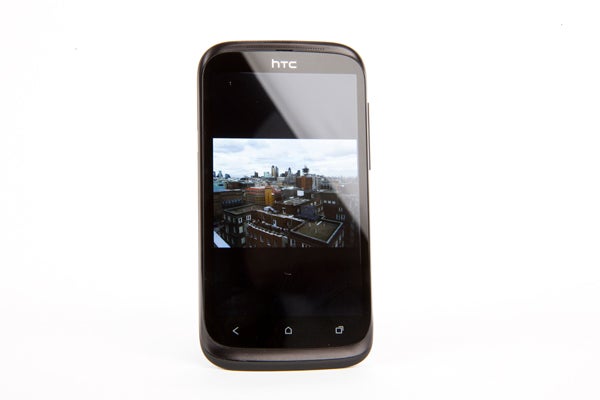
In newer versions of Android, locally stored videos are sidelined into the second half of an app that’s primarily there to flog the videos available on the Google Play store. Movie rentals from Google Play cost around £3.49.
HTC Desire X Battery Life and Connectivity
The HTC Desire X has a 1650mAh battery, but its stamina is not particularly noteworthy. With moderate-to-heavy use you’ll squeeze a full day out of the phone, but this is absolutely a phone you’ll have to charge up every day unless you switch off 3G connectivity. Doing so could be made easier too, as there’s no quick 3G toggle in the pull-down menu, unlike many other Android phones.
If you can spare the battery, the HTC Desire X offers a decent spread of connectivity. There’s Bluetooth 4.0 with aptX streaming for compatible Bluetooth audio devices, and the HSPA, GPS, Wi-Fi, Wi-Fi Direct and DLNA that every good Android phone deserves.
However, it does miss out on a few wireless connectivity extras. There’s no NFC and no 4G connectivity here. This is not a future-proof phone.
HTC Desire X Value
As the key makers of ultra-budget phones, ZTE and Huawei, continue to make more and more capable handsets, the ground underneath phones like the HTC Desire X gets more unsteady. It may be less powerful, but the Huawei Ascend G300 can do just about everything the HTC Desire X is capable of, for less than half the price.
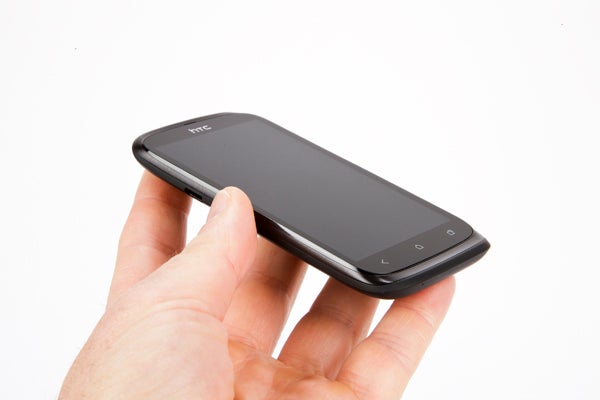
Compared to bigger-name rivals, the HTC Desire X is a much easier sell. One of its key rivals, the Samsung Galaxy Ace 2, is chunkier, lower-powered and altogether not as pretty without selling for much less cash. If you want a “known” name on your phone, this is one of our mid-range favourites.
HTC Desire X Verdict
The HTC Desire X lops off some features to squeeze its slim body into a lower-mid range pigeonhole. Most of these aren’t too critical. It uses a cut-down version of HTC Sense, has no user-facing camera and the main camera isn’t too hot. But it gets the basics down well. The screen is surprisingly good given its unimpressive specs, the dual-core processor makes sure it’s nippy and it’s generally a pleasure to use.
How we test phones
We test every mobile phone we review thoroughly. We use industry standard tests to compare features properly and we use the phone as our main device over the review period. We’ll always tell you what we find and we never, ever, accept money to review a product.
Trusted Score
Score in detail
-
Performance 8
-
Camera 6
-
Design 8
-
Usability 8
-
Value 8
-
Features 7
-
Screen Quality 8
General
| Height (Millimeter) | 118.5 mm |
| Width (Millimeter) | 62.3mm |
| Depth (Millimeter) | 9.3mm |
| Weight (Gram) | 114g |
Display
| Screen Resolution | 480 x 800 |
| Touchscreen | Yes |
Storage
| Internal Storage (Gigabyte) | 4GB |
Processor and Internal Specs
| CPU | Qualcomm MSM8225 Snapdragon |


